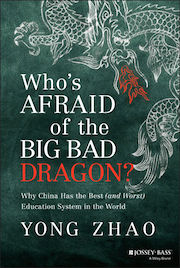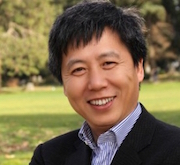The ‘Big Bad Dragon’ a Poor Education Model
Who’s Afraid of the Big Bad Dragon?
by Yong Zhao
Jossey-Bass (2014 – Learn more)

“The next Apple, the next Google will come, but probably not in China.”
So says Kai-fe Lee, founder of Innovation Works, an investment company in China. He was quoted in Yong Zhao’s excellent book World Class Learners: Educating Creative and Entrepreneurial Students (Corwin, 2012). He provided one of the most balanced and persuasive arguments against the high-stakes testing culture that is leading to the unfortunate standardization of American schools.

He sees China as a threat, but not in the economic or military sense. Instead, Zhao believes that the most harm comes from the United States’s misplaced adoration for China’s incredibly high scores on the Program for International Student Assessment, or PISA.
Emulating the Chinese educational system is not in the best interest of any country, Zhao believes. “Those actions betray a shallow understanding of a very old and complex culture, and they confuse short-term outcomes with long-term, sustainable progress” (28).
A History of Compliance
The beginning of China’s desire to “homogenize” its schools and students started in the 3rd century. A formal standardized test was developed a relatively short time later, called “the Keju system.” The purpose of Keju was to find the most loyal and compliant citizens to serve in office within China’s government. Those who tested well rose within the educational and bureaucratic ranks. China’s authoritarian government wanted total control over everything produced in their country: Food, resources, and anything else that would help solidify and sustain their country’s success.
While they found initial gains in controlling outputs for many centuries, moving into a post-industrialized world proved problematic. Lack of control, along with the loss of creativity and innovation skills, became a concern of many Chinese citizens. “Although they were excellent at perpetuating the past, they failed at inventing the future” (42).
In response, China passed a number of laws banning certain practices that led to these undesirable results. Attempts were made to remove severe admission restrictions on high schools and colleges and lessen high-stakes testing pressure. But the schools and the parents found ways around them. The old system with its culture of testing and ranking would not die.
Beyond Test Scores
The biggest reason why the U.S. is compared with China educationally is due to the PISA, the world’s report card. What is not often reported is the competition (and rampant cheating) that happens within China’s own schools. Students are ranked on a monthly, even weekly basis based on additional test results. These scores in the younger grades help decide the high schools students will eventually attend, which all but determines their career path. These pressures lead to early loss of hope, even teenage suicide.
This upward accountability mirrors the Chinese government’s hierarchical system of promoting the hardest workers, but often not the best learners. The few who speak out may ruin their own future. “Any criticism of this authoritarian culture is viewed as un-Chinese and anti-Chinese, inviting not rational discussion but emotional attacks” (111). As Zhao clearly shows, the PISA is only a small component of this culture’s overwhelming focus on piety and loyalty.
Zhao’s Lesson

Yong Zhao
After finishing this book, I initially felt like some things was missing. For example, what about Zhao’s own experience as a product of the Chinese education system? Also, what are the benefits of this system in today’s world? Is every Chinese family unhappy with their kids’ education?
While writing this review, I realized that neither the author’s life nor a balanced look at the Chinese education system was the point of the resource. Yong Zhao set out to write a devastating account of what learning can become when a government narrows their focus on student achievement to the core areas only, measured by a test that fails to recognize creativity or innovation. In that, he succeeded.
So why should we in the U.S. care? Because it is starting to happen here.
For example, in my own state of Wisconsin, our current state administration attempted to strike language from The Wisconsin Idea, a policy developed by the University of Wisconsin system that defines its contribution to the state. Specifically, the phrase “the search for truth” would have been replaced with “to meet the state’s workforce needs” as the university system’s purpose. Also, I would be remiss if I did not mention that K–12 schools in Wisconsin may soon be receiving rankings in the form of letter grades. Sound familiar?
Zhao’s lesson for all of us who care about education is that developing a compliant and homogenized workforce can lead to a society that lacks the ability to create and innovate. If, thanks to an unhealthy focus on standardized testing, kids are raised to believe that everything has one right answer, how can divergent thinking be developed?
To understand how the U.S.’s present infatuation with high-stakes testing will have a negative impact on our country and our lives, we need look no further than China’s past and present education history.
Matt Renwick is a 16-year public educator who began as a 5th and 6th grade teacher in a country school outside of Wisconsin Rapids, WI. After seven years of teaching, he served as a junior high dean of students, assistant principal and athletic director before becoming an elementary school leader in Wisconsin Rapids. Matt blogs at Reading by Example, tweets @ReadByExample and also writes for EdTech magazine and other publications. His book Digital Student Portfolios: A Whole School Approach to Connected Learning and Continuous Improvement was published in July 2014.






























